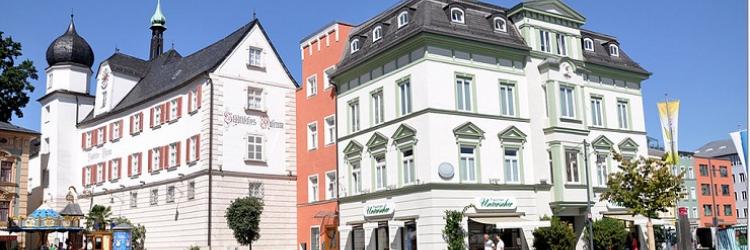Other Comments: 0 May 30, 2017
Rosenheim's history begins in the Roman era, when the Roman military power built an inn bridge and the military station "Pons Aeni". To whom the city owes the name and the coat of arms is not known, perhaps a man named Roso founded the place and the settlement was named after him. The theory that the name and coat of arms refer to the white rose in the coat of arms of the counts of Burghausen built by Rosenheim Castle cannot be verified. This was first documented in 1234.
The "Gillitzerblock" was built in 1894-1897 by the Munich entrepreneur Thomas Gillitzer. It included 15 houses between Gillitzer, Münchener and Prinzregentenstraße. A large part of the historic buildings were replaced by two large new buildings: the building of the Karstadt department store in the late 1960s and the construction of the new "Gillitzerblock" in the north-east area in the mid-1970s. In 1998 the Karstadt building was renovated.
The Max-Josefs Square, formerly the Inner Market, is today the "Guten Stube" of the city. Since 1984, the historic market square is pedestrian zone. The Max-Josefs Square is surrounded by magnificent houses in the Inn-Salzach style. Typical for this architectural style are the arcades, as well as the tomb roofs, which are hidden behind the sloping walls. A so-called »heavenly ladder« has been preserved in the Ellmaierhaus (Wood Technology Museum).
The Mittertor (Rosenheim's only surviving market gate) was the eastern gate of the market before 1350, which was then enclosed by a double trench. Since the 15th century it separated the inner market from the outer market and served as an administrative building. After 1641 the onion dome was built, and later the long building changed. In essence, the Mittertor is the oldest building in Rosenheim. Today, the Municipal Museum is located here, with its unique collection, dating from the Romans to the history of the city in the 20th century. The coat of arms of Rosenheim, the white rose on a red ground, is on the facade of the Mittertor on the side of the Ludwigsplatz. The Bavarian coat of arms can also be seen.
The Town Hall looks back on a turbulent history: in 1858 it was the first station in the Rosenheim railway station. But as early as 1878 the station was moved and the building became the Town Hall. It became known as a police station for the ZDF series "Die Rosenheim-Cops".
Exhibition Center Rosenheim: The cultural heart of the city of Rosenheim is the Exhibition Center Lokschuppen, which fascinates with outstanding exhibitions and a unique architecture for which was awarded the prize of the Bund Deutscher Architekten. Between 1857 and 1878, steam locomotives were accommodated here. Today, the locomotive shed is one of the ten most successful German exhibition halls in the Federal Republic and, with its scientifically founded and professionally staged event exhibitions, it has earned international attention.
Since 1987 the Salingarten has become a sculpture garden next to the Kultur + Kongresszentrum, where large sculptures of important sculptors from Rosenheim and the surrounding area can be seen. As an example, the bronze sculpture "Man and Horse" by Prof. Heinrich Kirchner, who taught at the Academy in Munich and lived in Seefeld in Pavolding. He often combined religious ideas with his works. Thus he placed man and animal on one and the same plane.
The 65-meter-high tower of the St. Nicholas parish church stands directly behind the market square and is the landmark of the city. The church was built around 1450 as a late Gothic building with a pointed helmet tower. 1641 Fire damage. 1642-57 the new construction with onion tower - the today's landmark of Rosenheim. The interior was changed several times according to the taste of the time, that is baroque or neo-gothic. In 1880, the church ship was extended by 3 yards towards Ludwigsplatz. From 1960 reorganization of the church interior. The earliest work of art of the Gotteshaus is the protective mantle image from 1514. A reconstruction of the church and a modern reconstruction of the interior took place in 2004-07. Remarkable are the new windows of the glass artist K.M. Hartmann, who were financed by Rosenheim citizens.
The hospital church of St. Joseph was built in 1618-19 by the citizen Simon Peer (Bürgerspitalstiftung). In 1641 the church burnt down. It was restored by Andreas Peer, the son of the founder. In the middle of the 18th century it was re-arranged (Baroque altar, Rococo chancery, paintings by the Rosenheim painter Joseph Anton Höttinger, representing the life of St. Joseph).
Evangelical Lutheran Church: The church was built between 1885 and 1886 in Neo-gothic style by the Leipzig architect and later Strasbourg cathedral architect August Hartel. In 1965, the altar area was redesigned. In the interior are three reliefs (replicas of the famous artist Adam Krafft), two paintings by the Traunstein painter from Kotzebue (paintings by Luther and Melanchthon), and since 1999 an abstract crossroads by the Munich artist Petra Winterkamp. The parish garden exhibits various art exhibitions.
Surrounded by romantic arcades in the pedestrian zone at the Max-Josefs Square, tourists can experience Mediterranean feeling of life - in the middle of Bavaria. When the weather is good there are full cafes lined one after another.Traditional restaurants and traditional beer gardens under shady chestnut trees attract people who are prone to the hedonistic way of living.. The Rosenheim beer, which has already won numerous awards, and tasty breads promise a real treat for every expert of Bavarian cuisine.


 RS
RS  ME
ME  HR
HR  BA
BA  RU
RU  MK
MK  AL
AL  ES
ES  DE
DE  IT
IT  CN
CN  NL
NL  SE
SE  FR
FR 






Write a comment